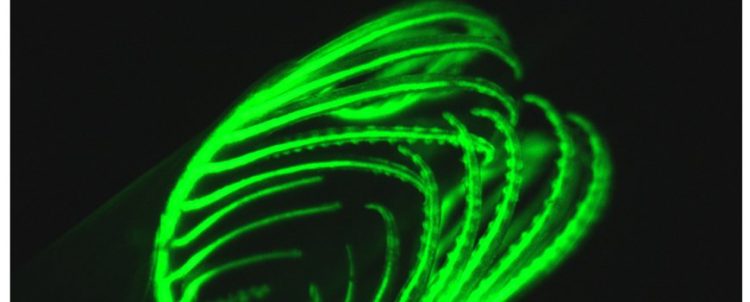Behind a Marine Creature’s Bright Green Fluorescent Glow

Green fluorescent glow emitted by a lancelet, a marine animal also known as 'amphioxus.'
Pushing closer to understanding the mechanisms behind the mysterious glow of light produced naturally by certain animals, scientists at Scripps Institution of Oceanography at UC San Diego have deciphered the structural components related to fluorescence brightness in a primitive sea creature.
In a study published in Scientific Reports, an open-access journal of the Nature Publishing Group, Dimitri Deheyn and his colleagues at Scripps Oceanography, the Air Force Research Laboratory, and the Salk Institute for Biological Studies have conducted the most detailed examination of green fluorescent proteins (GFPs) in lancelets, marine invertebrates also known as “amphioxus.”
The fish-shaped animals, which spend much of their time in shallow coastal regions burrowed in sand except for their heads, offer unique insights on natural fluorescence since individual specimens can emit both very bright and much dimmer versions of the light, a rare capability in the animal kingdom.
The study carries implications for a variety of industries looking to maximize brightness of natural fluorescence—the process of transformation of blue “excitation” light into green “emission” light—including applications in biotechnology such as adapting fluorescence for biomedical protein tracers and for tracking the expression of specific genes in the human body.
In investigating the structural differences between the proteins with the two levels of light output, known to be generated by the GFPs inside amphioxus, Deheyn and his colleagues found that only a few key structural differences at the nanoscale allows the sea creature to emit different brightness levels. The differences relate to changes in stiffness around the animal’s “chromophore pocket,” the area of proteins responsible for molecular transformation of light, and thus light output intensity.
“We discovered that some of the amphioxus GFPs are able to transform blue light into green light with 100 percent efficiency (current engineered GFPs—traditionally rooted in the Cnidarian phylum—only reach 60 to 80 percent efficiency), which combines with other properties of light absorbance to make the amphioxus GFPs about five times brighter than current commercially available GFPs, resulting in effect to a huge difference,” said Deheyn. “It is also interesting that the same animal will also express similar GFPs with an efficiency of about 1,000 times less.”
The exact mechanism that controls this ability of perfect efficiency during light transformation from blue to green remains unknown, Deheyn said, but this study opens doors towards its understanding.
“The most unique part of this discovery perhaps lays in the fact that for the first time, we show that different GFPs seem to have different functions within the same individual and unrelated to their ability to produce light, thus probably involving a biochemical role as well,” said Deheyn. “Nevertheless, having bright GFPs or the tool to increase brightness in current ones is critical for optimizing applications of fluorescence.”
Amphioxus are thought to use fluorescence for photo-protection (thus acting as sunscreen), as an antioxidant, and possibly for photo-sensing (using GFPs as receptors to the surrounding light) in their environment. Deheyn says learning more about bright-emitting GFPs in nature is useful for a variety of applications and fields of science.
“The U.S. Air Force, and the Department of Defense in general, uses a large variety of biosensors in biomedicine, bioengineering, and materials science, and providing proteins with the ability to be very bright can help technology advance because of better signal-to-noise ratio.”
Coauthors of the paper include Erin Bomati of Scripps Oceanography; Joy Haley of the Air Force Research Laboratory; and Joseph Noel of the Salk Institute for Biological Studies. The Air Force Office of Scientific Research supported the study.
Media Contact
All latest news from the category: Life Sciences and Chemistry
Articles and reports from the Life Sciences and chemistry area deal with applied and basic research into modern biology, chemistry and human medicine.
Valuable information can be found on a range of life sciences fields including bacteriology, biochemistry, bionics, bioinformatics, biophysics, biotechnology, genetics, geobotany, human biology, marine biology, microbiology, molecular biology, cellular biology, zoology, bioinorganic chemistry, microchemistry and environmental chemistry.
Newest articles

High-energy-density aqueous battery based on halogen multi-electron transfer
Traditional non-aqueous lithium-ion batteries have a high energy density, but their safety is compromised due to the flammable organic electrolytes they utilize. Aqueous batteries use water as the solvent for…

First-ever combined heart pump and pig kidney transplant
…gives new hope to patient with terminal illness. Surgeons at NYU Langone Health performed the first-ever combined mechanical heart pump and gene-edited pig kidney transplant surgery in a 54-year-old woman…

Biophysics: Testing how well biomarkers work
LMU researchers have developed a method to determine how reliably target proteins can be labeled using super-resolution fluorescence microscopy. Modern microscopy techniques make it possible to examine the inner workings…





















